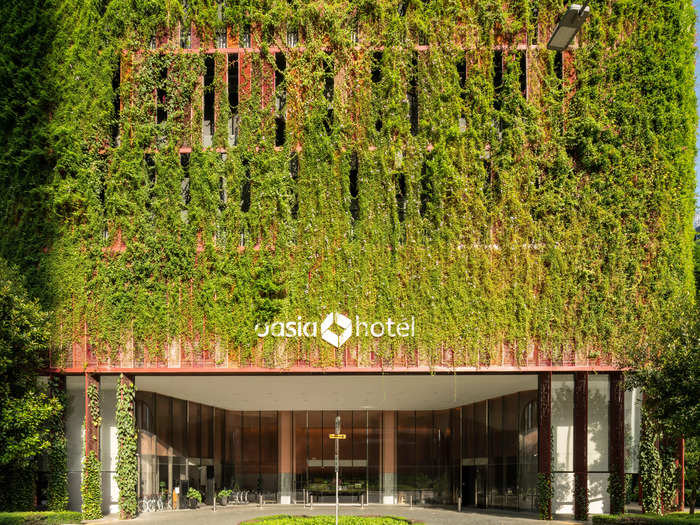Inside Singapore's famous 'living tower,' a 620-foot hotel that's covered in red mesh and is being intentionally overrun with greenery
Amanda Goh

- Oasia Hotel Downtown is a "living tower" in Singapore's central business district (CBD).
- The building has a red mesh facade that's covered in 21 different species of plants.
In the heart of Singapore's Central Business District (CBD) stands a vibrant tower of green among a sea of concrete. Completed in 2016, Oasia Hotel Downtown has a "living facade" that's covered in plants.

Designed by Singapore-based Woha Architects, the project cost $138 million Singapore dollars ($100 million) to build, per a factsheet sent to Insider. Construction started in 2012 and was completed four years later.
Unlike the glass and concrete skyscraper designs that much of the city-state is known for, this 624-foot building is covered in a red aluminum facade mesh that holds up 21 different species of creeping plants, per the factsheet. The plants are arranged at different elevations depending on their sunlight requirements, wind resilience, and speed of growth.
Although the building is named after the hotel, it's designed to be a mixed-use building — there are also office spaces available for rent.
Singapore has made a point of ensuring that its built environment coexists with the natural world.

The city-state has a total land area of 728.3 square kilometers, or 281.3 square miles. With a population of over 5.5 million people, Singapore has had to maximize space and build upwards — at the expense of the greenery that once covered the land.
To minimize the impact on the natural environment, the government has implemented strict building regulations, including a program known as "Landscaping for Urban Spaces and High-rises" (LUSH).
"The city sets a certain ratio in terms of how much landscape the developer needs to create on top, on the side, or even inside the building to compensate for the landscape that's lost on the ground," architect and "Supertall" author Stefan Al told Insider.
Apart from building sky gardens and "living roofs," developers are also encouraged to choose plants with a higher leaf area index, Al wrote in his book.
The building's "living facade" starts at the ground level.

The various creeper plants on the building bloom at different times, creating a facade that changes its appearance intermittently.
"It is a living artwork of nature that changes with light and shade, rainfall, and the natural cycle of plant life," Phua Hong Wei, a director at Woha Architects, told Insider.
Instead of a flat top, the mesh facade extends above the building, creating a crown that provides an extra 140 feet for plants to grow, per the factsheet.

All of this contributes to Oasia Hotel Downtown's stellar green plot ratio. The green plot ratio measures the density of greenery within a development, per the Urban Redevelopment Authority.
Oasia Hotel Downtown has a green plot ratio of 1,100%, meaning the total area of plants on the building can compensate for the lack of greenery on 10 similar-sized sites, Phua said.

"It shows that tall buildings can be meaningful habitats even beyond the ground plane," he added.
When viewed from the inside, the combination of the greenery and the mesh wall creates a dense, wall-like atmosphere that's well-shaded from the sun. The above photo is taken from the parking garage on the hotel's fourth floor.
There are also four sky gardens in the building, which are home to another 33 species of plants and trees, per Woha.

The sky garden on the 12th story of the hotel features a lawn and a lounge area. It also doubles as a wedding venue that can hold up to 60 people, per the hotel's website.
The green facade helps reduce the urban heat island effect, in which urban environments experience much higher temperatures than neighboring rural areas.

In Singapore, this difference in temperature can go up to seven degrees Celsius, per a study from the National University of Singapore.
Greenery can help cool hard surfaces and the air of urban environments, Phua said.
"Thermographic images taken at 1 p.m. show that Oasia's facade is up to around 25 degrees Celsius cooler than typical curtain wall surfaces," Phua said. "This means less radiative and convective heat transfers back into the urban environment, which helps to combat the urban heat island effect."
Oasia Hotel Downtown is not the only green building in Singapore. Many other developments in the city, including some public housing developments, have also incorporated greenery into their designs.

Completed in 2009, Pinnacle@Duxton is the world's tallest public housing project, per the Singapore Tourism Board. Its seven buildings are connected by two bridges on the 26th and 50th floors, each of which has a 500-meter-long garden.
Then there's Marina Barrage, a dam built across the Marina Channel to create the city's largest reservoir. The barrage's main building has a green roof the size of four football fields.
The architecture firm behind Oasis Hotel Downtown has also designed another hotel in the city with a "living roof": Parkroyal Collection Pickering features a terraced design that adds 15,000 square meters (161,458 square feet) of plants to the building, per Woha Architects.
Popular Right Now
Popular Keywords
Advertisement